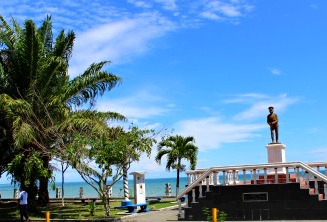
I will take the opportunity to tell you about a few neighborhoods in this post.
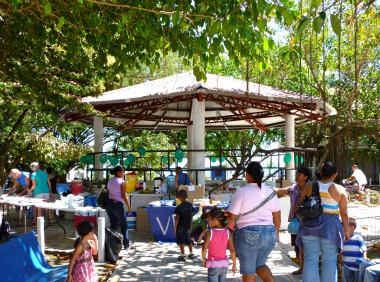
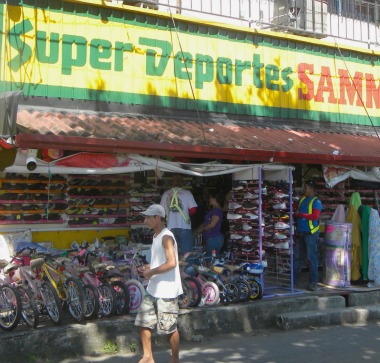
Puerto Armuelles' Downtown is a compact four block, by four block grid of shops built side by side.
The commercial area is dense. There are over a hundred small shops in the downtown.
These shops include three or four banks, numerous small grocery stores and a couple of larger ones, a gas station, exercise gyms, numerous fruit and vegetable stands, a fish market, and more.
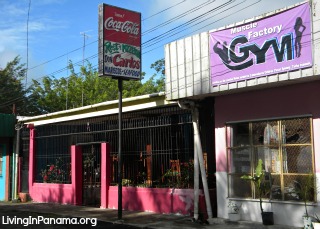
The large, modern grocery store (Romero) is just a few hundred meters from downtown.
Don Carlos Restaurant Is A Good Place To Eat - Across street from the downtown waterfront park
The Carmen neighborhood starts right at the downtown pier, and goes south for perhaps, twenty blocks.
It was explained to us that Chiquita had designed its neighborhoods to suit the professional hierarchy of its workers.
This meant that, since Carmen was built to house the dock workers, it was located right by the loading dock, and the houses were modest, on rather small lots.
Like all of the Chiquita built homes, the houses in Carmen are simple wooden-sided structures, built above the ground on posts.
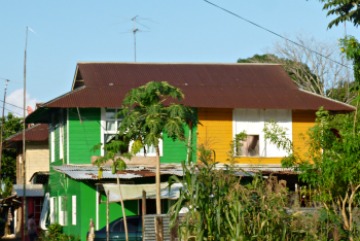
Painted a rainbow of colors, the neighborhood has the look of a funky, hippy
Carmen Is A Colorful Neighborhood With Many Duplexes<
neighborhood somewhere on the beach in California.
Since we're from Seattle, which is quite urban, and a little bit funky, we were attracted to Carmen.
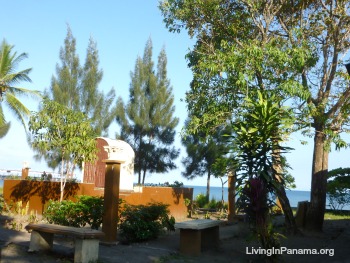
If it hadn't been for our desire for more space for our children, we might have bought one of the many, very affordable, fixer-uppers in El Carmen.
Park By The Ocean In Carmen
So far, perhaps half a dozen ex-pats have remodeled El Carmen houses into comfortable beach homes.
One can still buy a house in Carmen for around ten thousand dollars.
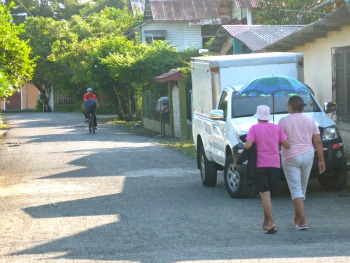
Driving south along the ocean through Carmen, one next arrives in the San Vicente neighborhood.
Talking A Stroll In Carmen
Here there is dramatic change in style, since the wooden houses on stilts are immediately replaced by the typical concrete stucco houses with tin roofs that one sees all over Panama.
Obviously, this neighborhood was outside the Chiquita built zone.
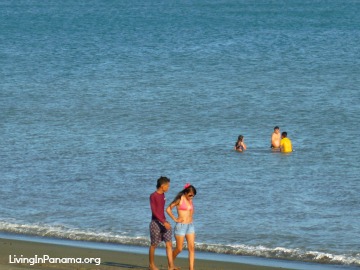
Another thing one notices about San Vicente is that it is a lot less dense than El Carmen, and much quieter.
Popular Day At Beach In San Vicente Neighborhood
In fact, after spending a little time in San Vicente exploring, one begins to realize that most of the oceanfront lots are big, or even vacant, and that some of the lots a block or two off the beach are as large as half an acre, and quite vacant.
San Vicente is a working class neighborhood of streets on a grid, that would have been a excellent choice for our family to have moved, though we eventually settled on a different neighborhood.
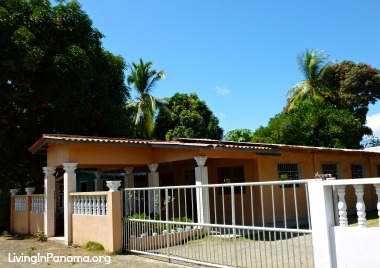
There are a few beachfront restaurants in San Vicente, including one just being completed by an ex-pat,
House Across Street From Ocean In San Vicente Neighborhood
who used to run a catering business in the states.
Back to downtown and heading north along the ocean, one quickly passes through the Pueblo Nuevo
The Pueblo Nuevo Neighborhood is about three blocks of very narrow, curving streets with densely packed wooden Chiquita houses up on stilts.
This was another Chiquita laborers' neighborhood.
This is my favorite neighborhood to bike through, since the high density wooden houses, brightly colored as in El Carmen and the narrow, curving one-lane, one way streets with drainage canals on both sides for storm runoff, remind me more of canals than of asphalted streets.
If I squint my eyes and imagine that the wooden houses are masonry, I get the feeling that I am in Venice and that the asphalt is the water of a canal.
Don't get me wrong, Pueblo Nuevo is a neighborhood in gross disrepair, as is most of Puerto Armuelles.
Plus, I have a vivid imagination.
I may be the only one, not hallucinating, who sees anything interesting about Pueblo Nuevo, but I think it's super cool.
One ex-pat restaurant owner from Bocas del Toro agrees with me, since he is building a new restaurant in Pueblo Nuevo.
Pueblo Nuevo is right next to downtown.
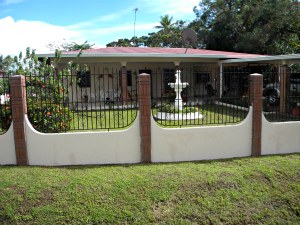
Crossing the tiny bridge out of Pueblo Nuevo one arrives in Rio Mar.
Rio Mar Is A Quiet Neighborhood
Rio Mar has a few blocks of Chiquita houses, eventually giving way to typical Panamanian style houses.
In this neighborhood there are a number of finely maintained homes with beautiful private gardens.
Rio Mar is one of the biggest neighborhoods and seems to go on for perhaps ten blocks east-west, as well as north-south.
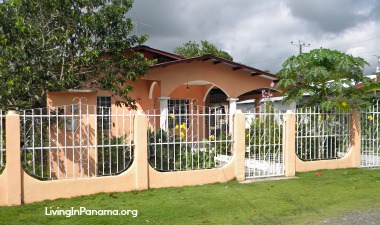
The big baseball stadium is in Rio Mar. It is used for the rare national semi-pro games, which are fun to watch.
A Nice Panamanian Style House In Rio Mar
Tickets cost $1.
Starting again from downtown. Head north on the main road that goes to Pasa Canoas.
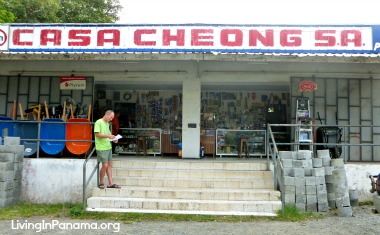
About 300 yards from downtown, you will see Casa Cheong on the left hand side.
Casa Cheong Is Next To Romero Supermarket
Casa Cheong is my favorite hardware store.
They usually have what you're looking for. If it's a small item, I can ride my bike, since it's so close to town.
Right next to Casa Cheong is the very modern Romero's grocery store.
Romero's was always a neat and tidy grocery, belonging to a small chain of stores.
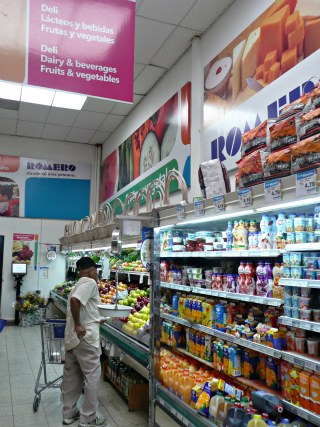
However, Romero has just gotten even better, since they were acquired by
Romeros Is the Best Grocery Store in Puerto - 300 yards from downtown
the El Rey chain of
groceries.
El Rey is the premier grocery chain in Panama, with products and organization that seem identical to that in a modern U.S. Supermarket.
If one continues to drive North another 500 meters, one can enter the San Jose neighborhood by turning right just after the bridge.
If you were paying attention, you will remember having seen the first row of San Jose houses from the main road as you drive into town.
San Jose is another Chiquita-built neighborhood, of painted wooden houses built up on stilts.
San Jose's Pleasant Homes Don't Have Much Of A Yard
However, most of the home owners in San Jose have enclosed the ground floor with masonry to capture more living space.
San Jose was built for mid-level managers of the company.
This is a small neighborhood, right off the main road.
However, since it is separated from other areas of town by the main road on one side, the old railroad right-of-way on the other, as well as a creek which crosses beneath the old railroad bridge, it feels quite separate and special.
My family and I rented a house in San Jose while our own house was being remodeled.
Since San Jose houses are on smaller lots, we were concerned that it would be noisy.
We were pleasantly surprised to discover that we were very comfortable and happy in San Jose.
Since our youngest daughter was only two at that time, we could walk with her in the jogging stroller to Romero's to buy groceries, or we could walk into downtown to go sit on a bench at the waterfront park, or use the swing set at the play park.
If one returns downtown and heads west past the Puerto Armuelles Super Mercado (a grocery store), one passes a row of shops on the left, including a bakery which makes reasonable baked goods.
If you get to the bakery at the right moment, the cinnamon rolls will be coming out of the oven. Their warm cinnamon rolls are quite yummy.
This city street has just been shortened by a block. The owner of new and upscale City Mall department store in Paso Canoas, recently purchased and razed the existing building to make way for a new super-center in Puerto, similar to the one they own at the Paso Canoas.
Another couple hundred yards west is the old Chiquita softball field. This is a popular spot to watch Sunday baseball games. It has shaded bleachers, a beer garden, and raspado (ie snowcones) vendors.
As you've probably heard, Panama is a baseball loving country.
Here in Puerto, the men's softball league must have dozens of teams. Everyone, of every shape and size, plays ball.
Since I wanted to do as the locals do, I even dusted off my old baseball glove, which hadn't been used in thirty years or so, and joined a team.
The coach gave me his old uniform to wear, which I found quite flattering.
Unfortunately, I only lasted five games. One really has to be willing to dedicate the entirety of Sunday to the team.
The games rarely start on time, and if one team doesn't show up, your own team may be called to play in two or three games in a row.
And then there's all the beer drinking after the game. This can last for hours.
The family and I cast a vote and decided that we would rather have Sunday be our "Family Beach Day", so I have retired my old baseball glove to moth balls yet again.
Right next to the Stadium is the fire house, which proudly sports a faded red fire engine built in the U.S. In 1961.
Rumor has it that they have never successfully saved a burning house.
Their explanation is that the wooden houses which are made mostly of dry red cedar, imported from the U.S. By Chiquita, burn too quickly for them to have a chance of saving them.
They are proud to claim that never has a fire spread to a neighboring house.
To borrow a baseball metaphor, like the great Panamanian Relief pitcher for the Yankees, Mariano Rivera, the Puerto Armuelles fire department is focused on the "save" and not the "win".
When the city fresh water system has been under repair, the fire department has been indispensable in its main role of filling water tanks for residents, since many homes have a large tank suspended in the air on a tower, since water pressure is not guaranteed throughout the day.
In four years, we've only been without water a couple of times. Our 180 gallon tank has plenty of water to get us through the night on days when the city pressure fails during the day.
Directly across from the Fire Station is the Mayor's house. He puts up a big Christmas light display every year.
Go here for a summary of many neighborhoods in Puerto Armuelles